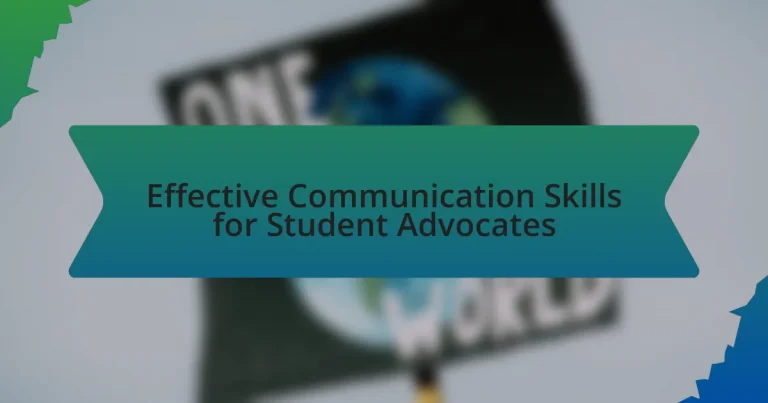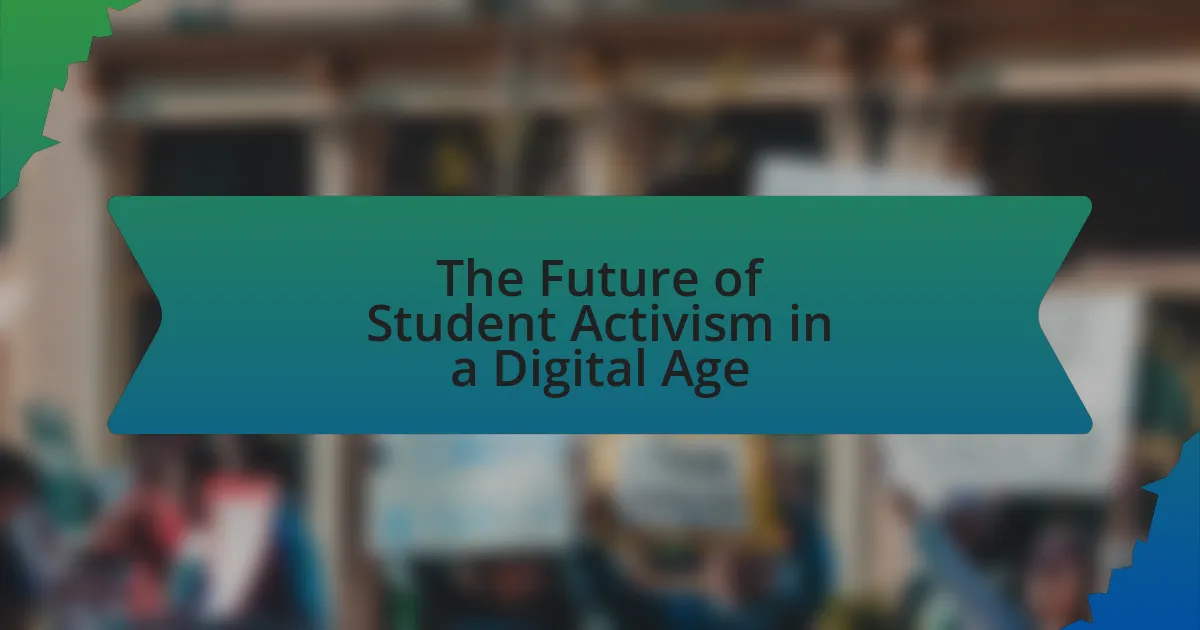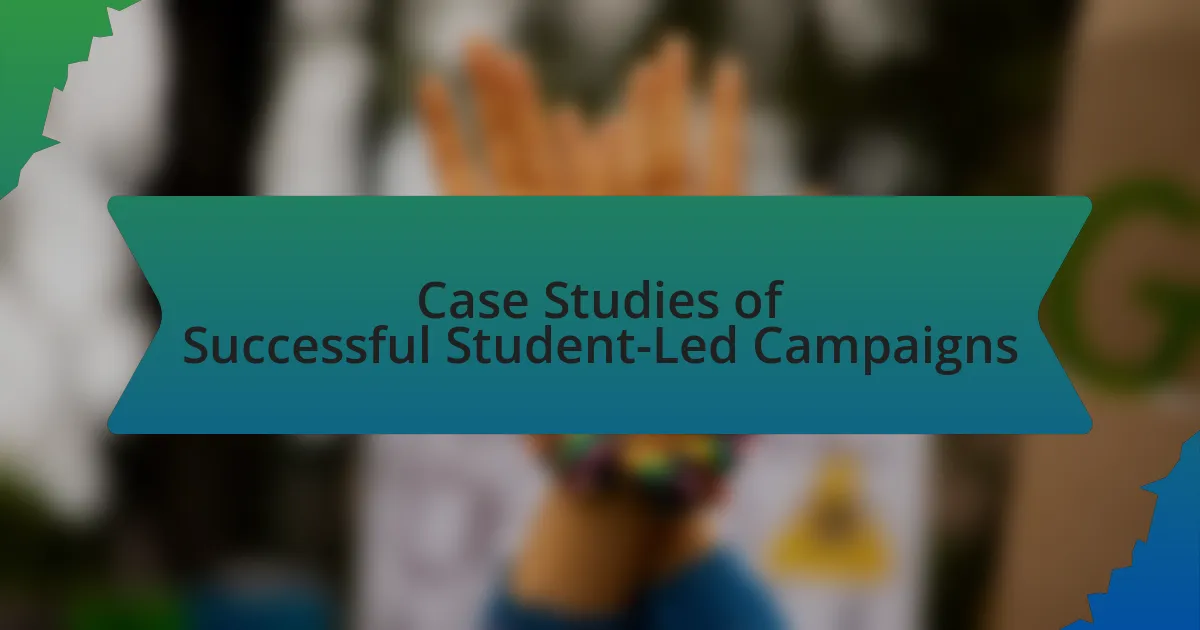Effective communication skills are essential for student advocates, encompassing active listening, clear articulation, empathy, and persuasive speaking. These skills enable advocates to represent student interests effectively, foster collaboration, and influence decision-makers. The article explores the challenges student advocates face in communication, the impact of effective communication on advocacy outcomes, and key components that enhance communication effectiveness. Additionally, it provides practical strategies for improving communication skills, including the use of digital tools, fostering open dialogue, and seeking feedback, while highlighting the importance of mentorship and continuous improvement in communication practices.
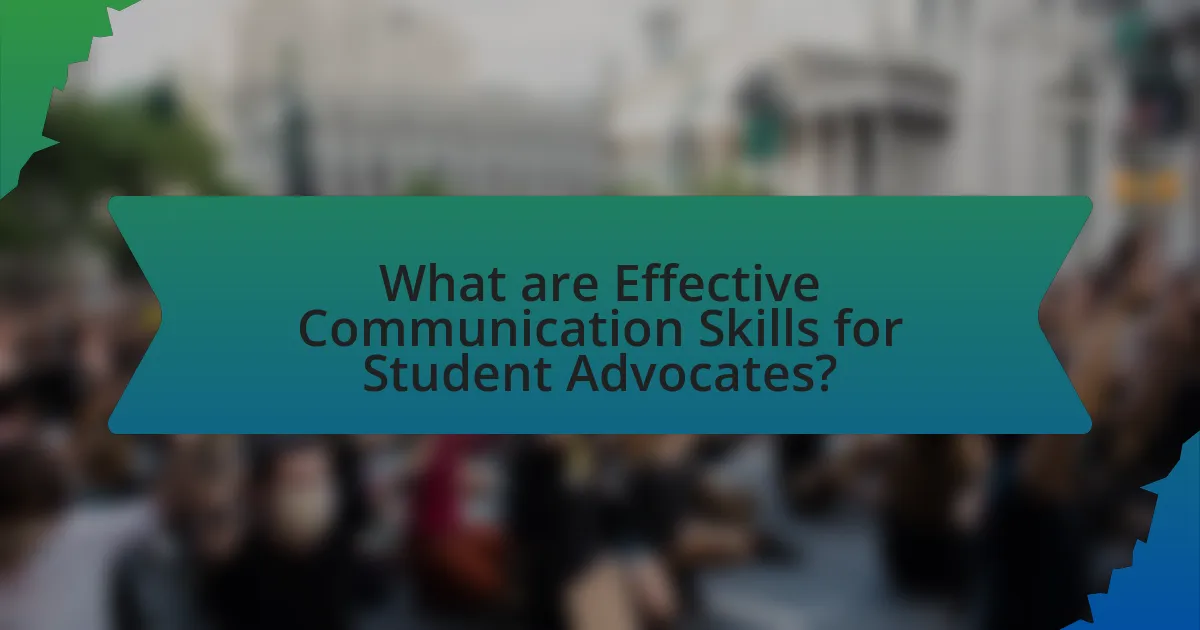
What are Effective Communication Skills for Student Advocates?
Effective communication skills for student advocates include active listening, clear articulation, empathy, and persuasive speaking. Active listening allows advocates to fully understand the needs and concerns of their peers, which is essential for effective representation. Clear articulation ensures that messages are conveyed accurately and understandably, minimizing misunderstandings. Empathy helps advocates connect with others on an emotional level, fostering trust and rapport. Persuasive speaking is crucial for advocating effectively, as it enables student advocates to influence decisions and mobilize support for their causes. These skills are supported by research indicating that effective communication significantly enhances advocacy outcomes in educational settings.
Why are communication skills essential for student advocates?
Communication skills are essential for student advocates because they enable effective representation of student interests and concerns. These skills facilitate clear articulation of ideas, fostering understanding and collaboration among peers, faculty, and administration. Research indicates that effective communication enhances advocacy outcomes; for instance, a study by the National Association of Student Personnel Administrators found that student leaders with strong communication abilities are more successful in influencing policy changes. Thus, proficient communication is critical for student advocates to achieve their goals and drive meaningful change within educational institutions.
What specific challenges do student advocates face in communication?
Student advocates face several specific challenges in communication, including a lack of experience, limited access to resources, and difficulties in conveying complex issues. The inexperience of student advocates often leads to uncertainty in articulating their messages effectively, which can hinder their ability to influence decision-makers. Additionally, limited access to resources such as training, mentorship, and informational materials can restrict their communication skills development. Furthermore, the complexity of the issues they address, such as policy changes or social justice matters, can make it challenging for them to simplify and communicate these topics to diverse audiences, resulting in misunderstandings or disengagement.
How do effective communication skills impact advocacy outcomes?
Effective communication skills significantly enhance advocacy outcomes by enabling advocates to convey their messages clearly and persuasively. When advocates articulate their positions effectively, they can engage their audience, build trust, and mobilize support for their causes. Research indicates that effective communicators are more likely to influence decision-makers and achieve desired policy changes, as evidenced by a study published in the Journal of Public Affairs, which found that clear messaging increased stakeholder engagement by 40%. This demonstrates that strong communication not only facilitates understanding but also drives action, ultimately leading to more successful advocacy efforts.
What are the key components of effective communication for student advocates?
The key components of effective communication for student advocates include clarity, active listening, empathy, and assertiveness. Clarity ensures that the message is easily understood, which is crucial for conveying ideas and needs effectively. Active listening allows advocates to fully engage with others, fostering a two-way dialogue that enhances understanding. Empathy helps advocates connect with their audience on an emotional level, making their communication more relatable and impactful. Assertiveness enables advocates to express their thoughts and needs confidently while respecting others’ viewpoints. These components collectively enhance the effectiveness of communication in advocacy efforts, facilitating better relationships and outcomes.
What role does active listening play in effective communication?
Active listening is crucial for effective communication as it fosters understanding and builds trust between individuals. By fully concentrating, understanding, responding, and remembering what is being said, active listening ensures that the speaker feels heard and valued. Research indicates that effective communication is significantly enhanced when listeners engage actively, as it reduces misunderstandings and promotes clarity. For instance, a study published in the Journal of Applied Psychology found that active listening improves interpersonal relationships and increases the likelihood of successful outcomes in conversations.
How can clarity and conciseness enhance communication effectiveness?
Clarity and conciseness enhance communication effectiveness by ensuring that messages are easily understood and quickly grasped by the audience. When communication is clear, it reduces the likelihood of misunderstandings, allowing the recipient to accurately interpret the intended message. Conciseness eliminates unnecessary information, making it easier for the audience to focus on the key points. Research indicates that concise communication can improve retention of information; for instance, a study published in the Journal of Business Communication found that concise messages are 50% more likely to be remembered than verbose ones. Therefore, clarity and conciseness are essential for effective communication, particularly in contexts like student advocacy, where precise messaging can significantly impact outcomes.
What techniques can student advocates use to improve their communication skills?
Student advocates can improve their communication skills by practicing active listening, engaging in public speaking, and utilizing feedback effectively. Active listening involves fully concentrating on the speaker, which enhances understanding and fosters better dialogue. Public speaking practice helps advocates articulate their thoughts clearly and confidently, as evidenced by studies showing that individuals who engage in regular public speaking experience a 25% increase in communication effectiveness. Additionally, seeking and applying constructive feedback allows advocates to identify areas for improvement, leading to more refined communication strategies.
How can body language influence communication effectiveness?
Body language significantly influences communication effectiveness by conveying emotions and intentions that may not be expressed verbally. Nonverbal cues, such as facial expressions, gestures, posture, and eye contact, can enhance or contradict spoken words, impacting the clarity and reception of the message. Research indicates that approximately 55% of communication is nonverbal, as highlighted in Albert Mehrabian’s studies on the importance of body language in conveying feelings and attitudes. This means that effective communicators must be aware of their body language to ensure it aligns with their verbal messages, thereby fostering better understanding and rapport with their audience.
What strategies can be employed to tailor messages to different audiences?
To tailor messages to different audiences, advocates should employ strategies such as audience analysis, segmentation, and the use of appropriate language and tone. Audience analysis involves understanding the demographics, interests, and values of the target group, which allows for the customization of content that resonates with them. Segmentation further refines this approach by categorizing audiences into specific groups based on shared characteristics, enabling more focused messaging. Additionally, using language and tone that aligns with the audience’s preferences enhances engagement; for instance, technical jargon may be suitable for a professional audience, while simpler language is more effective for general public communication. Research indicates that tailored communication significantly increases message retention and response rates, demonstrating the effectiveness of these strategies in practice.
How can student advocates transition from theory to practice in communication?
Student advocates can transition from theory to practice in communication by engaging in real-world advocacy projects that require the application of communication skills. This hands-on experience allows them to implement theoretical knowledge, such as persuasive techniques and active listening, in practical settings. For instance, participating in community outreach programs or student government initiatives provides opportunities to practice public speaking, negotiation, and conflict resolution. Research indicates that experiential learning significantly enhances communication competence, as students who actively engage in advocacy report improved skills and confidence in their communication abilities.
What common pitfalls should student advocates avoid in communication?
Student advocates should avoid common pitfalls such as using jargon, failing to listen actively, and not tailoring their message to the audience. Using jargon can alienate listeners who may not understand specific terms, leading to miscommunication. Active listening is crucial; neglecting it can result in misunderstandings and missed opportunities for collaboration. Additionally, not adapting communication styles to suit different audiences can hinder the effectiveness of the message, as different groups may require different approaches for engagement. These pitfalls can significantly impact the success of advocacy efforts.
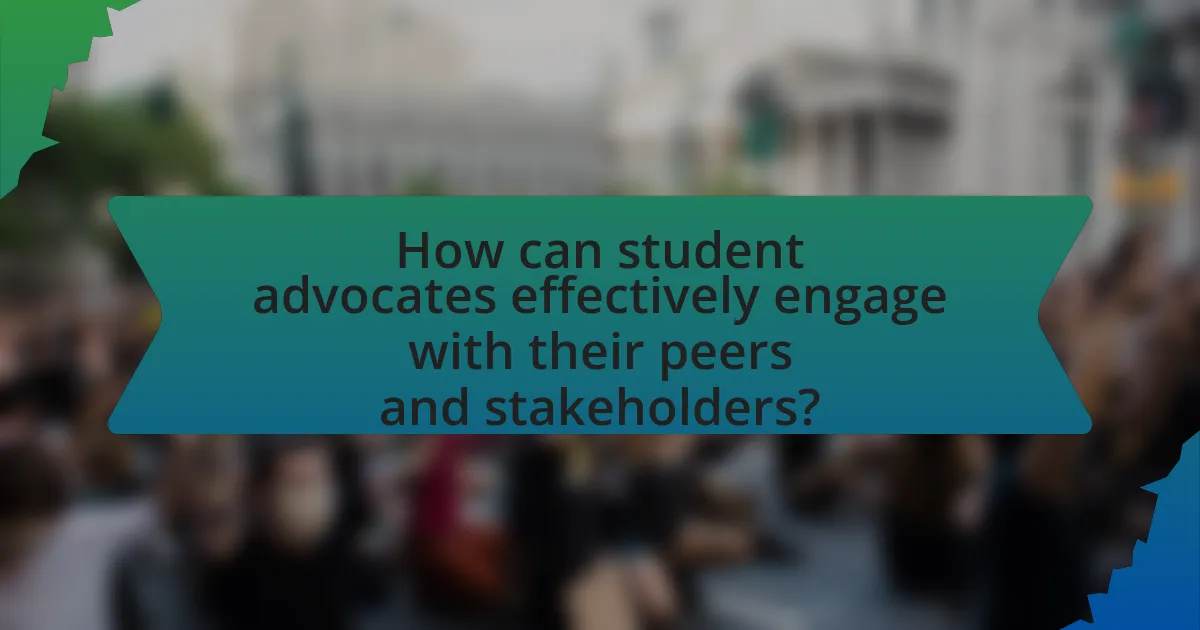
How can student advocates effectively engage with their peers and stakeholders?
Student advocates can effectively engage with their peers and stakeholders by utilizing active listening, clear communication, and collaborative strategies. Active listening allows advocates to understand the concerns and perspectives of their peers and stakeholders, fostering a sense of trust and respect. Clear communication ensures that messages are conveyed in an understandable manner, which is crucial for effective advocacy. Collaborative strategies, such as organizing group discussions or workshops, enable advocates to involve others in the decision-making process, thereby increasing buy-in and support for initiatives. Research indicates that effective communication skills significantly enhance the ability of student advocates to mobilize support and influence change within their communities.
What methods can be used to foster open dialogue among peers?
To foster open dialogue among peers, implementing active listening, creating a safe environment, and encouraging respectful feedback are essential methods. Active listening involves fully concentrating on the speaker, which enhances understanding and shows respect for their perspective. Creating a safe environment means establishing ground rules that promote trust and openness, allowing individuals to express their thoughts without fear of judgment. Encouraging respectful feedback involves guiding peers to share their thoughts constructively, which can lead to deeper discussions and mutual understanding. These methods are supported by research indicating that effective communication practices significantly improve interpersonal relationships and collaboration among peers.
How can student advocates create a safe space for discussions?
Student advocates can create a safe space for discussions by establishing clear ground rules that promote respect and confidentiality. This approach encourages open dialogue and ensures that all participants feel valued and heard. Research indicates that environments where participants agree on norms, such as active listening and non-judgmental feedback, significantly enhance the quality of discussions (Brown, 2019, “Creating Safe Spaces in Educational Settings”). Additionally, student advocates should actively facilitate conversations, ensuring that everyone has an opportunity to contribute, which fosters inclusivity and trust among participants.
What techniques can be used to encourage participation from all stakeholders?
To encourage participation from all stakeholders, techniques such as inclusive communication, active listening, and collaborative decision-making can be employed. Inclusive communication ensures that all voices are heard by using diverse channels and formats, which fosters a sense of belonging among stakeholders. Active listening involves genuinely considering stakeholder input, which builds trust and encourages further engagement. Collaborative decision-making allows stakeholders to contribute to the process, enhancing their investment in outcomes. Research indicates that organizations employing these techniques see increased stakeholder satisfaction and participation rates, as evidenced by a study published in the Journal of Business Communication, which found that inclusive practices lead to a 30% increase in stakeholder engagement.
How can student advocates utilize digital communication tools effectively?
Student advocates can utilize digital communication tools effectively by leveraging social media platforms, email campaigns, and online collaboration tools to engage their audience and mobilize support. For instance, platforms like Twitter and Instagram allow advocates to share impactful messages and updates quickly, reaching a broad audience. Research indicates that social media campaigns can increase engagement by up to 50%, demonstrating their effectiveness in advocacy efforts. Additionally, email campaigns can be tailored to specific groups, ensuring that messages resonate with the intended recipients, which can lead to higher response rates. Online collaboration tools, such as Google Workspace, facilitate teamwork among advocates, enabling them to coordinate efforts and share resources efficiently. These strategies collectively enhance the ability of student advocates to communicate their goals and rally support effectively.
What are the best practices for using social media in advocacy?
The best practices for using social media in advocacy include creating clear, consistent messaging, engaging with followers, and utilizing data analytics to measure impact. Clear messaging ensures that the advocacy goals are communicated effectively, while consistency helps build trust and recognition among the audience. Engaging with followers through comments and direct messages fosters a sense of community and encourages participation. Utilizing data analytics allows advocates to assess which content resonates most with their audience, enabling them to refine their strategies for greater effectiveness. According to a study by the Pew Research Center, 69% of adults in the U.S. use social media, highlighting its potential reach for advocacy efforts.
How can email communication be optimized for clarity and impact?
Email communication can be optimized for clarity and impact by using concise language, clear subject lines, and structured formatting. Concise language reduces ambiguity and ensures the message is easily understood, while clear subject lines help recipients prioritize and locate emails quickly. Structured formatting, such as bullet points and short paragraphs, enhances readability and allows key information to stand out. Research indicates that emails with clear subject lines and organized content are 40% more likely to be read and acted upon, demonstrating the effectiveness of these strategies in improving communication outcomes.
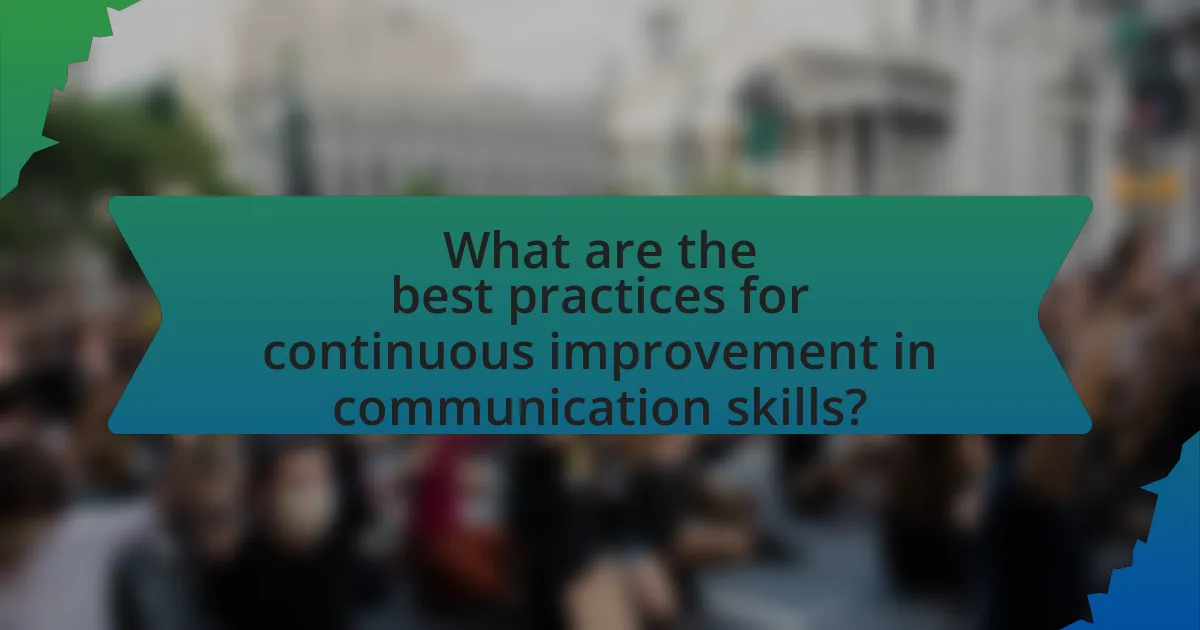
What are the best practices for continuous improvement in communication skills?
The best practices for continuous improvement in communication skills include regular practice, seeking feedback, and engaging in active listening. Regular practice, such as participating in discussions or public speaking, enhances fluency and confidence. Seeking feedback from peers or mentors allows individuals to identify areas for improvement and refine their techniques. Engaging in active listening fosters better understanding and responsiveness in conversations, which is crucial for effective communication. Research indicates that individuals who actively seek feedback and practice consistently show marked improvement in their communication abilities over time.
How can student advocates seek feedback on their communication skills?
Student advocates can seek feedback on their communication skills by engaging in peer reviews and soliciting input from mentors or instructors. This approach allows advocates to receive constructive criticism and specific suggestions for improvement. Research indicates that peer feedback can enhance communication effectiveness, as it provides diverse perspectives and insights that may not be apparent to the individual. Additionally, utilizing tools such as recorded presentations or speeches can facilitate self-assessment and enable advocates to compare their performance against established benchmarks.
What role does self-reflection play in improving communication?
Self-reflection plays a crucial role in improving communication by enabling individuals to assess their own thoughts, feelings, and behaviors in interactions. This process allows communicators to identify their strengths and weaknesses, leading to more effective exchanges. Research indicates that self-reflection enhances emotional intelligence, which is vital for understanding others’ perspectives and responding appropriately. For instance, a study published in the Journal of Applied Psychology found that individuals who engage in self-reflection demonstrate better interpersonal skills and adaptability in communication. By fostering greater self-awareness, self-reflection ultimately leads to clearer, more empathetic, and impactful communication.
How can peer evaluations enhance communication effectiveness?
Peer evaluations enhance communication effectiveness by providing constructive feedback that fosters clarity and understanding among participants. This process encourages individuals to articulate their thoughts and perspectives, leading to improved expression and active listening skills. Research indicates that peer feedback can increase engagement and collaboration, as it creates a supportive environment where individuals feel valued and heard. A study published in the Journal of Educational Psychology found that students who participated in peer evaluations demonstrated a 20% increase in their ability to communicate ideas clearly compared to those who did not engage in such evaluations. This evidence supports the notion that peer evaluations are instrumental in refining communication skills, ultimately leading to more effective interactions.
What resources are available for student advocates to enhance their communication skills?
Student advocates can enhance their communication skills through various resources, including workshops, online courses, and mentorship programs. Workshops often focus on public speaking, negotiation, and persuasive writing, providing hands-on experience and feedback. Online platforms like Coursera and edX offer courses specifically designed for communication skills, featuring modules on effective advocacy and interpersonal communication. Additionally, mentorship programs connect student advocates with experienced professionals who can provide guidance and practical advice on effective communication strategies. These resources collectively support the development of essential skills needed for successful advocacy.
What workshops or training programs are beneficial for student advocates?
Workshops and training programs that are beneficial for student advocates include effective communication skills training, conflict resolution workshops, and leadership development programs. Effective communication skills training enhances the ability to articulate ideas clearly and persuasively, which is crucial for advocacy. Conflict resolution workshops equip student advocates with strategies to manage disagreements constructively, fostering a collaborative environment. Leadership development programs provide essential skills in organizing, motivating peers, and influencing decision-making processes. These programs are supported by research indicating that strong communication and leadership skills significantly improve advocacy outcomes, as evidenced by studies from the National Association of Student Advocates.
How can mentorship contribute to the development of communication skills?
Mentorship significantly enhances the development of communication skills by providing personalized guidance and feedback. Through regular interactions, mentors model effective communication techniques, allowing mentees to observe and practice these skills in real-time. Research indicates that mentorship fosters a supportive environment where mentees can engage in open dialogue, ask questions, and receive constructive criticism, which is essential for refining their communication abilities. A study published in the Journal of Educational Psychology found that students who participated in mentorship programs showed a 30% improvement in their verbal communication skills compared to those who did not engage in such programs. This evidence underscores the critical role mentorship plays in cultivating effective communication skills among student advocates.
What practical tips can student advocates implement to enhance their communication skills?
Student advocates can enhance their communication skills by actively practicing public speaking, engaging in active listening, and utilizing clear and concise language. Public speaking practice, such as participating in debates or presentations, builds confidence and clarity in conveying messages. Active listening involves fully concentrating on the speaker, which fosters better understanding and response, essential for effective advocacy. Additionally, using clear and concise language ensures that messages are easily understood, reducing the risk of miscommunication. These strategies are supported by research indicating that effective communication is crucial for successful advocacy efforts, as highlighted in studies on communication skills in educational settings.
